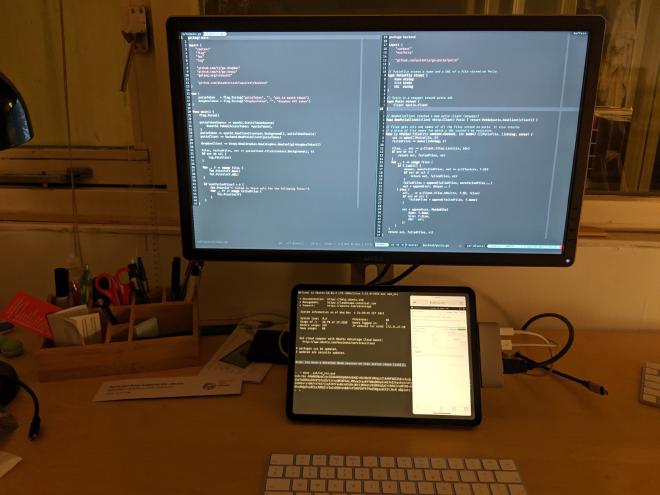Sunk cost of my iPad Pro
In January 2019 I bought an 11-inch iPad Pro. It’s a magnificent piece of hardware that you can read many reviews of online. The screen is brilliant, the portability and battery life are unmatched, the performance is swift (until you’re trying to perform a long-running CPU-intensive operation, that is).
The iPad Pro was always meant to be my “personal computing” device. I don’t really code in my free time anymore, so issues of not being able to run VS Code on it are not my issues. I do some music production, lightweight photo editing and I write, that’s all I require from my personal computer. (ah yes, and the “occasional Netflix”) So at first glance the magnificent iPad Pro should be amazing, shouldn’t it? Turns out that for me, it wasn’t, for many tiny reasons. Tech reviewers sometimes refer to this as “the 10%” of things you need to be able to do on your computer, because indeed the iPad Pro can often handle that 90%. Yet even with iPadOS (aka iOS 13), which made it much more a real computer than any previous software upgrade, there’s still a ton of things that it either doesn’t do well, or doesn’t do at all. I agree with Gruber: the iPad didn’t fulfill the potential that was always in the hardware itself, even after 10 years of being on the market.

Of all the issues that I’ve had, there were two major ones:
- Input. Apparently I’m not an Apple Pencil person, I find handwriting on the screen awkward, even with absolutely brilliant apps that take advantage of it in a spectacular way. I need a keyboard, and none of the keyboard cases I could find pleased me. Probably the new Magic Keyboard could do the trick, but I won’t buy one and I’ll get to why in a moment.
- Limited connectivity with external hardware. Yes, the iPad Pro has a usb-c port which is much better than having a Lightning port, but a) there’s only one, so you’ll be living the #donglelyfe even if your peripherals actually use usb-c, and b) iPadOS limits the kind of protocols it allows the apps to use for transferring data over usb-c. So if your hardware uses a custom protocol, it won’t work on the iPad.1
It baffles me now when I think of how much time and money I spent trying to make my iPad setup work well for me. Any obstacle I encountered I tried finding a workaround for, or I’d buy some accessory to help me deal with it. I also kept believing that Apple will gradually improve the software and, by doing so, address all my concerns. To be fair it did happen to a certain degree, but the starting point of the reasoning was flawed. I bought a product for the potential of what it could one day be, and not for what it was. And once I did, I fully committed to my “investment,” not wanting to face the hard truth that it simply did not work for me. It’s a perfect illustration of two economic or psychologic principles: post-purchase rationalization and the sunk cost fallacy.
The first one we’re all very familiar with, it’s the fallacy where humans generally try to remember their past choices as better than they actually were. We do this with many of our decisions, and the bigger the cost of making a choice, the more our brain supports it later. The second one is famously attributed to Concorde development—the British and French governments took their past investments as a factor when deciding on whether to continue the project. It applies to human relationships, too, and, as I experienced, to consumer decisions.2
This post, then, isn’t a caveat emptor, I’m not trying to discourage anyone from buying an iPad, nor am I saying it’s a bad purchase in general. On the contrary, it’s amazing in many ways. The reason I wrote all this down is that it took me by surprise how far I’d gone into my sunk cost, and it made me reevaluate many of my past choices (no, I’m not divorcing my wife). I invite you, dear reader, to do the same, and now please excuse me while I go to the Apple store online and spend an insane amount of money on a new laptop.
There is a 3rd but very niche yet infuriating problem that relates to both of the issues above that not many people care about, as it relates to me being Polish. All the Polish Mac users I know install Karabiner-Elements as one of the first apps after getting a new Mac. This software allows for remapping the keyboard, most importantly swapping the right ⌘ with right ⌥ key, in order to get Alt Gr (which is required to input Polish characters) right next to the space, so that you can press it with your thumb and not die. There is no way to achieve the same thing on the iPad with an external keyboard. Unless you make the keyboard yourself I guess. This niche problem remains niche, but illustrates perfectly what’s wrong with the iPad. ↩︎
Side-note: how often does sunk cost fallacy apply to software projects? How many projects were you part of, dear reader, when a decision was made to stick to old, buggy, messy ways of doing things simply because “we’ve already invested so much time and effort into this system”? Food for thought. ↩︎